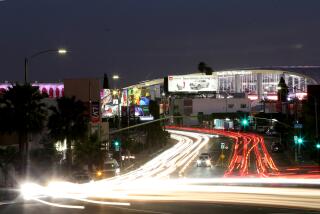Angels Flight rides again
- Share via
The orange and black funicular cars of Angels Flight still displayed their customary rattle and shake as they climbed the 298-foot tracks up Bunker Hill on Monday, maintaining the feel familiar to generations of Angelenos who have ridden “the smallest railway in the world.”
“It’s got the same kind of little grinding,” said Craig Moreland, whose grandfather once owned Angels Flight. He was one of the first to step on board when the rail line reopened for business Monday morning. “All the noises are as I recall them.”
Although Angels Flight has not changed, the city around it has.
When Angels Flight closed after a fatal accident in 2001, a new generation of urban dwellers was just settling into their lofts. In the intervening years, trendy restaurants, high-rise condos, luxury loft conversions and a full-fledged art district have reshaped the neighborhoods that spread east and south of the railroad’s base.
The funicular has been out of commission for so long, said Bert Green, a downtown resident and gallery owner, that for many of the area’s new denizens, “it’s not just a restoration of a link that has been neglected. It’s going to be something new.”
That change is only the latest transformation in the short railroad’s long history. For much of its life, beginning in 1901, Angels Flight connected the Victorian houses and wooden bungalows that once crowned Bunker Hill with the bustling commerce at the bottom of the hill. By the late 1960s, both ends of the slope were in transition. Bunker Hill’s residential blocks had been razed to make way for high-rise office towers, and the downtown below was struggling after decades of decline.
Angles Flight closed in 1969 -- for what civic officials had said would be a matter of months -- and reopened in 1996. Then, on Feb. 1, 2001, one of the rail line’s two cars, Sinai, broke loose and sped 200 feet backward, smashing into the other car, Olivet, at the bottom of the hill.
An 83-year-old New Jersey man was killed, and seven people were seriously injured.
Federal investigators eventually concluded that faulty mechanical and brake systems, combined with weak oversight, led to the crash.
On Monday, with its safety problems resolved, according to local and state officials, Angels Flight returned to a downtown Los Angeles that once again has a thriving residential neighborhood -- but this time at the bottom of the hill.
And atop Bunker Hill stand the Walt Disney Concert Hall and a growing collection of cultural attractions.
No one expects Angels Flight to suddenly become a vital transportation link -- walking up Bunker Hill is far from an ordeal.
But downtown boosters see the funicular as a cultural link, a piece of history reborn to help connect the new downtown.
“You are talking about bridging the past and the present in a way that is pretty rare in L.A.,” Green said.
His gallery is in the Old Bank District, a few blocks from Angels Flight’s terminus at the bottom of Bunker Hill.
He sees the reopening of the funicular as an opportunity for more cross-pollination between the arts scene in his area -- known for the monthly art walks that draw thousands to galleries -- and the more established art scene at the top of Bunker Hill, which is home to the Museum of Contemporary Art and the Music Center.
Josh Rogosin, who works in public radio and moved downtown from New York last year, checked out Angels Flight on Monday morning and left impressed.
He probably would not use the rail line every day, he said, but it definitely makes the downtown living experience richer.
“I look forward to riding it not because I have to, but because I like the distinctiveness of it,” he said. “This is why I like big cities.”
A sense of history and urban atmosphere are part of what has drawn many new residents to downtown in the last few years.
For some, the attraction was highlighted by the movie “(500) Days of Summer,” in which the main character’s obsession with Bunker Hill and the Old Bank District made the settings around Angels Flight featured players, although the funicular was out of commission and did not appear.
“One of the things about Angels Flight is that for an object, it has personality,” said John Welborne, president of Angels Flight Railway. “The fact is, it’s an animated part of downtown.”
Others see Angels Flight more pragmatically as help for getting around.
The revitalization of downtown has occurred in pockets.
There’s Bunker Hill, the Old Bank District, the Arts District near Little Tokyo and South Park around Staples Center and L.A. Live.
Carol Schatz, president and chief executive officer of the Downtown Center Business Improvement District, said that figuring out ways to connect these areas by mass transit has been a top priority.
Officials are considering several big-ticket items -- including a trolley down Broadway and a rail connector running through downtown to Union Station.
Angels Flight, by contrast, is famously small, but Schatz believes it will make a difference.
When Angels Flight opened Dec. 31, 1901, at 3rd and Hill streets, its founder, Col. J.W. Eddy, touted the funicular as a way to spare Angelenos the walk up Bunker Hill -- for the price of 1 cent.
It reopened in 1996 at its current location about a block from the original site.
For historian Marc Wanamaker, Angels Flight is a symbol of sorts, of the loss of the Bunker Hill that thrived in the early part of the last century, when the hilltop was a centerpiece of the city, dotted by luxurious mansions, before Bunker Hill was shaved down and those mansions razed.
“It is a symbol of L.A. past,” Wanamaker said, “of a quality of life, of an actual different topography and a different way of living.”
More to Read
Go beyond the scoreboard
Get the latest on L.A.'s teams in the daily Sports Report newsletter.
You may occasionally receive promotional content from the Los Angeles Times.







